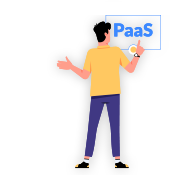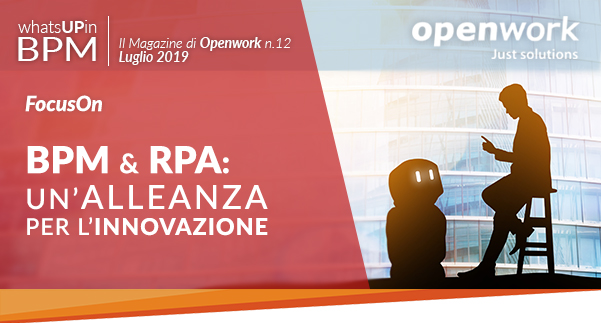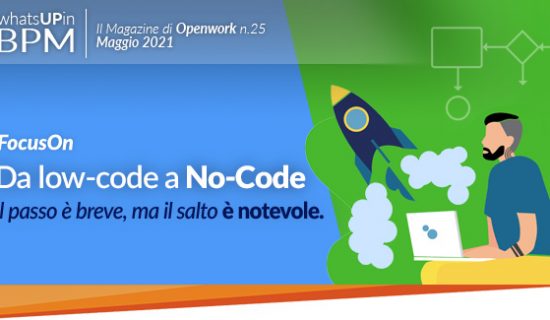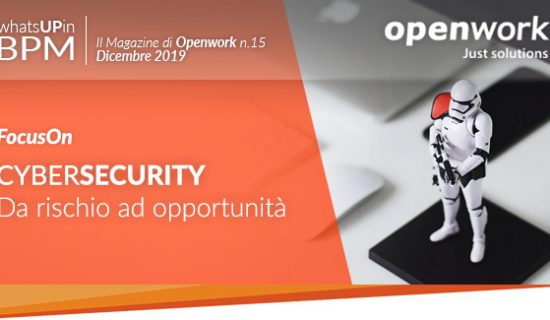Planning and implementing a successful digital transformation for an organization is not an "overnight" process. In fact, it is a transformation that also has profound implications on organizational structures and must be designed and implemented with the involvement of all the resources of the organization .However, there are some technologies that can be used to accelerate the whole process; among them, BPM ( Business Process Management) technologies , an integral and enabling part of digital transformation strategies for many years.
The expression Business Process Management means the set of activities required to model, optimize, integrate and monitor business processes in order to make the company's business efficient and effective. Rethinking the company in terms of process means implementing organizational and operational models that enable all stakeholders to share information and coordinate their actions according to common goals, not just individual ones.
Adopting BPM technologies means for the organization to initiate a new orientation, both technological and cultural, to speed up and simplify workflows, increase productivity and improve competitiveness, making the organization flexible to market changes.
Robotic Process Automation (RPA) is emerging as a topic of interest for organizations that intend to digitize and thus to speed up the many manual processes that still remain entrusted to people. The Institute for Robotic Process Automation (IRPA) defines RPA as "the set of technologies, products and processes involved in the automation of work processes and uses so-called 'software robots' that can automatically perform the repetitive tasks of operators, imitating their behavior and interacting with computer applications in the same way as the operator himself."
RPA technology is ideal for automating and optimizing repetitive manual tasks, allowing people to focus on higher value-added tasks. Their adoption is in established and stable business processes, perhaps outsourced, easily defined through a closed set of rules that are transferable to the robot and have no exceptions or only a few that are easily solved.
The characteristic elements of RPA technology can be summarized as follows
- can be defined as software that replicates actions otherwise performed by a human operator;
- can be implemented quickly and efficiently without altering the existing infrastructure and systems;
- Is focused on performing repetitive, time consuming and manual tasks
Robotic process automation is gaining popularity in many industries, finance, banking, and utilities above all, where procedures and best practices exhibit characteristics just described and are likely to simplify and streamline repetitive manual tasks.
Examples of such automation include: searching for information on various sites, format translations, extracting structured data from documents, moving files and folders, filling in user masks, connecting to external systems, all by executing simple "if/then" type rules .
One should not make the mistake of simplifying the terms BPM and RPA by overlapping them or considering them synonymous. They are two quite distinct technologies with their own characteristics.
It is from their complementary use that end-to-end process automation and governance can be achieved while drawing maximum value for the organization. In fact, as a complementary tool to BPM, RPA can help companies to be faster and more flexible by mechanizing processes that are partially or completely unsupported by software, which are always costly for people.
At the same time, their combined use means maximizing the benefits from the use of BPM, thus investing more in human activities that require high professionalism and greater specialization, making unstructured processes such as those related to certain approval circuits more fluid, dynamically orchestrating human tasks and system tasks of multiple processes governed and monitored by BPM solutions.
How to proceed?
The starting point is always a comprehensive analysis of the company's business processes, their modeling on a BPM platform, identification of tasks that can be delegated to a robot, and integration with RPA tools. The BPM platform enables such an evolved approach to digital transformation by providing the ability to
- Integrating cognitive and AI tools to support intelligent process management
- Support the construction of case management applications
- Support integration with external services based on the most advanced standards such as Open API REST
As an example, imagine the process of managing a loan application to a bank made online by a customer. The entire complex and articulated process will be modeled on the BPM platform and involves a number of "human intensive" tasks such as those of verification, validation and approval.
During the execution steps of the modeled process, activities delegated to robots such as automatic form filling that initiate the approval process with structured information from the request form or integration with the bank's legacy systems to acquire customer risk data generate the invocation from connector process of the chosen RPA component that presents the REST API protocol.
Ultimately, combining the flexibility and power of BPM and the use of intelligent robots inherent in RPA is the key to achieving the goals of successful end-to-end digital transformation

Editorial by:
Piero Cosoli - Senior Program Manager Openwork
OPENWORK NAVIGATES WITH RANDSTAD TOWARD NEW DIGITAL MODELS

And it is precisely in the port of Bari, aboard the aforementioned sailing ship Clipper Stad Amsterdam held dalily cruise and a workshop titled "Computing and philosophy: will it ever be true love?"
The workshop analyzed the new development models brought by the advent of artificial intelligence and the new ways of conceiving work derived from the integration of humans and machines.
Speakers included Roberto Rossi (Head of Technologies at Randstad Italy), Martin Arborea (Co-Founder & Sales Director of Openwork), Mariarita Costanza (Co-Founder & CTO Macnil Gruppo Zucchetti) and Andrea Geremicca (Co-Founder & CMO Impactscool).
Openwork confirms itself at the center of the digital innovation debate by bringing its contribution to IT through its Zero-Code development approach, which allows cloud applications to be created without programming language knowledge. A winning response to another sensitive issue such as the digital skills crisis plaguing Italian companies.
OPENWORK WEBINAR - Check out the appointments with the new Openwork format

The Openwork Webinar project is born, an extensive webinar schedule through which the presenter will lead participants into the zero-tail world of Jamio, while being in the comfort of the office, or at home, or from any device with Internet access, at a designated day and time.
Numerous topics addressed to different interlocutors: CIOs, IT managers or other business areas, Jamio designers and users, Var, consulting companies, etc. with the aim of making Jamio known, illustrating its features, peculiarities, functionalities, novelties, application cases, bringing the interlocutors as close as possible to the Jamio Model driven cloud.
The first webinar " The Future of Business Processes is Zero-Code" is already available online every Wednesday at 12:00 noon, every Thursday at 3:00 pm. The Webinar tells about the simplicity of the Zero-Code modeling approach of the Jamio Openwork BPM platform, building together a step-by-step solution for digitizing business processes.
Instead, the second webinar "3 Important New Features of Jamio Marimba 4.5" showing the new features of the latest Jamio versions will be available online every Wednesday at 3 p.m. and every Thursday at 12 noon.
Instead, from September you can follow the webinar "One Platform Many Solutions." Through an example case, a peculiarity of the platform will be told: Jamio allows you to implement an unlimited number of solutions for one organization and use them from one workspace, sharing data and information.
Open for vacations: the Cloud never goes on vacation

The Cloud Jamio does not go on vacation! We would like to remind you that the Customer Service for Jamio openwork customers will remain operational throughout August to ensure customers and partners get the assistance they may need.
ONE MINUTE TO EXPLAIN HOW IT CAN CHANGE YOUR WORK WITH JAMIO
In an ever-changing market, you need technologies to follow your needs.
Here is Jamio's video.
















